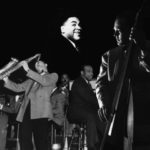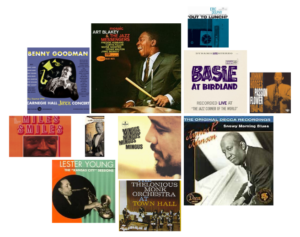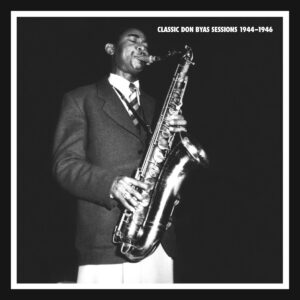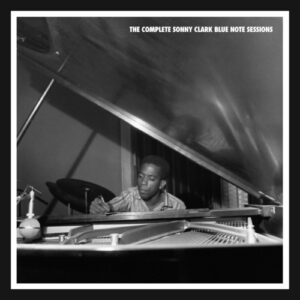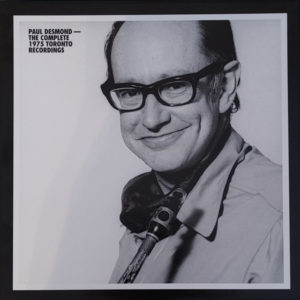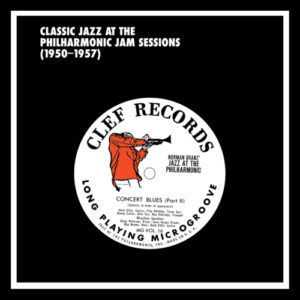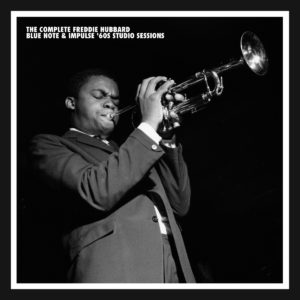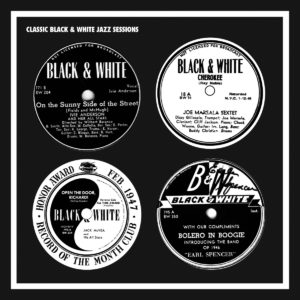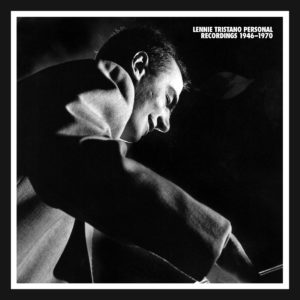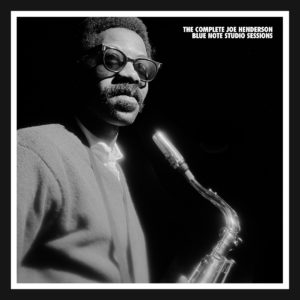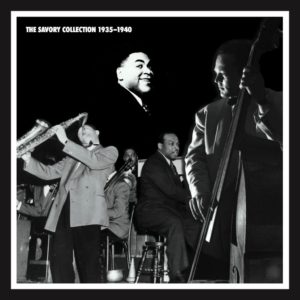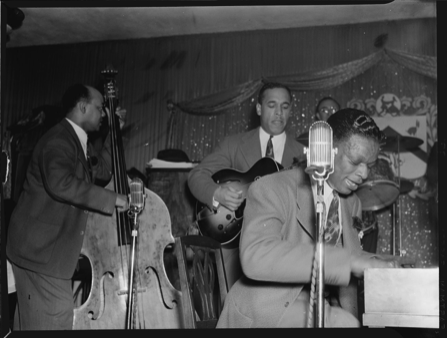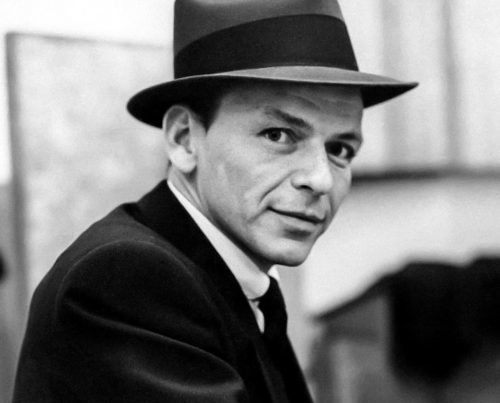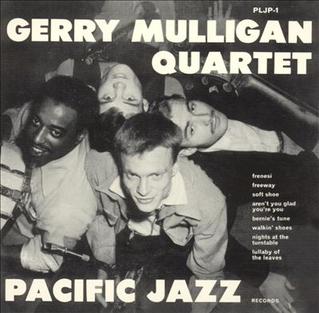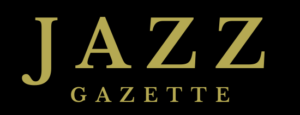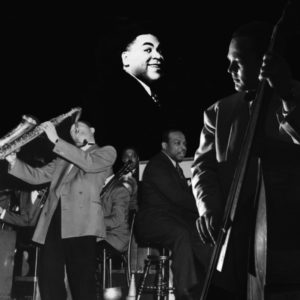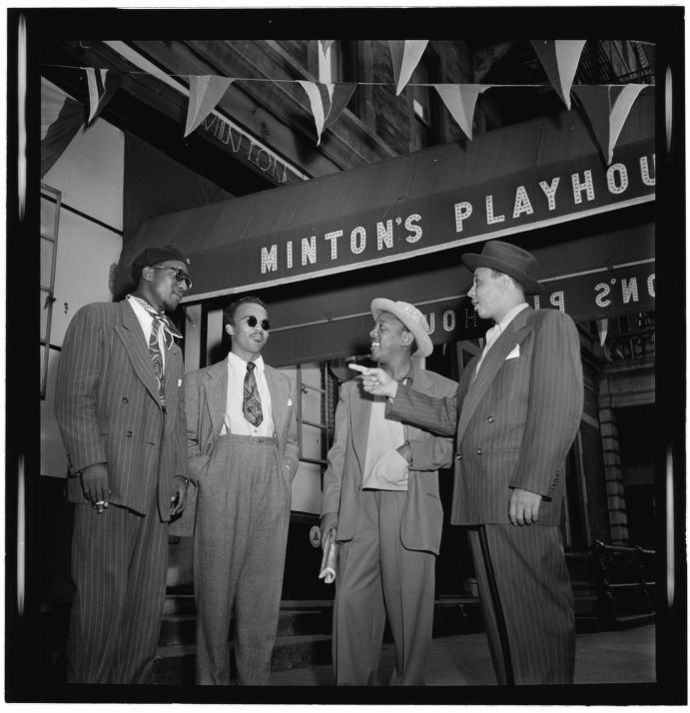
BeBop
While in hindsight, bebop is a logical extension of swing, at the time of its sudden emergence in 1945, bebop seemed to many listeners to be a radical new music that came out of nowhere.
Bebop had actually developed gradually during the previous five years but few of bebop’s early steps were documented due to the musicians union recording strike of 1942-44.
Bebop changed the function of the rhythm section from how it had been during swing and early jazz. Instead of the pianist keeping time by striding with his or her left hand, a bebop pianist used his or her left hand to play irregular accents while the right often improvised speedy single-note hornlike lines. Drummers played unpredictable accents (called “dropping bombs”) with the main timekeeping function being given to the string bassist.
Even though some of the bebop originals used chord changes “borrowed” from swing standards, they were often made more harmonically complex while original and tricky melody lines became the new themes. Much of the time the melody was played in unison (rather than harmonized) and then discarded altogether during solos before returning during the final chorus. Jazz musicians were given the freedom of improvising over chord changes rather than playing off of the melody.
It took a few years but bebop eventually became the new mainstream of jazz.-Scott Yanow
Coleman Hawkins: Rainbow Mist
Of all of the swing era veterans, tenor-saxophonist Coleman Hawkins (1904-69) was the most open new sounds of bebop. On Feb. 16, 1944, he led what is considered the first bebop jazz recording session, inviting many of the young modernists to be part of the date. In addition to a pretty modern rhythm section (pianist Clyde Hart, bassist Oscar Pettiford and drummer Max Roach), Hawkins featured the always-adventurous trumpeter Dizzy Gillespie including on Dizzy’s original “Woody’n You.”
Featured Track: Woody’n You
While Gillespie was heard for the first time stretching out in his own style (having previously been a modern variation of his original role model Roy Eldridge), Hawkins shows in his own spots that he had no trouble fitting in with the young turks.
Dizzy Gillespie: Groovin’ High
The two co-founders and greatest practitioners of what in jazz music came to be known as bebop teamed up on many occasions during their breakthrough year of 1945. Altoist Charlie Parker (1920-55) was arguably the greatest saxophonist of all time while Dizzy Gillespie (1917-93) had very few competitors among trumpeters.
Featured Track: Hot House
Tadd Dameron’s “Hot House” utilized the chord changes of Cole Porter’s “What Is This Thing Called Love” without ever hinting at Porter’s melody. After the opening statement, Parker and Gillespie take brilliant and unpredictable solos while the rhythm section (pianist Al Haig, bassist Curly Russell and drummer Sid Catlett) plays quintessential bebop
Charlie Parker: The Complete Savoy and Dial Recordings
Charlie Parker became such an influential force in jazz that even his throwaway phrases became part of the jazz vocabulary. On “Ko Ko,” which is based on “Cherokee,” Parker and Dizzy Gillespie take breaks while just accompanied by drummer Max Roach.
Featured Track: Ko Ko
Parker then improvises all of the way through a two chorus solo full of ideas that would soon be adopted by others but were actually made up on the spot by the altoist.
Dizzy Gillespie: Groovin’ High
Bebop was considered so complex by many observers when it first burst upon the scene that it was taken for granted that it was primarily a style for small groups. Dizzy Gillespie proved otherwise by forming a big band that could play any new music that it was given.
Featured Track: Things To Come
The Dizzy Gillespie Orchestra, which lasted during 1946-49, had a large repertoire with its most adventurous song being “Things To Come,” co-written by Gillespie and arranger Gil Fuller. The original version featured solos by Gillespie and vibraphonist Milt Jackson but is most notable for the futuristic ensembles which still sound advanced 75 years later
Bud Powell: The Complete Bud Powell On Verve
One of the most important innovators of the bebop era, Bud Powell (1924-66) changed the way that the piano functions in modern jazz and became the main influence on younger pianists of the 1945-60 period. In addition to his superb piano playing, Powell was also a skilled composer.
Featured Track: Celia
“Celia,” performed in a trio with bassist Ray Brown and drummer Max Roach, is one of his most charming pieces.
Fats Navarro: Goin’ To Minton’s
Theodore “Fats” Navarro (1923-50) was second to Dizzy Gillespie among bebop era trumpeters, becoming a major influence on Clifford Brown and the trumpeters to follow. He mastered bebop at an early age and quickly developed his own distinctive voice within the music.
Featured Track: Eb Pob
“Eb Pob” (BeBop backwards) has Navarro taking a particularly exciting solo in a quintet with jazz artists baritonist Leo Parker, pianist Tadd Dameron, bassist Gene Ramey, and drummer Denzil Best
Thelonious Monk: Milt Jackson and the Monk Quintet
Thelonious Monk stood apart from the bebop era just as Duke Ellington had during the swing era. While Monk was part of the jam sessions at Minton’s Playhouse in the early 1940s that helped develop the new music, by the mid-1940s his piano playing and original compositions were so individual that they fell into their own musical world.
Featured Track: Evidence
“Evidence,” which has a percussive theme that disguises the fact that the song was based on “Just You, Just Me,” was first recorded in 1948 in a quartet that also featured vibraphonist Milt Jackson. On this initial version, the composer plays the melody behind Jackson’s solo chorus and then comes up with an improvisation that only Thelonious Monk could have created.
Charlie Parker and Dizzy Gillespie: Jazz At Massey Hall
One of the last times that Charlie Parker and Dizzy Gillespie played together was at a special all-star concert that also included pianist Bud Powell, bassist Charles Mingus, and drummer Max Roach. It was the only time that these five masters all appeared on stage in the same group and this is on most top ten live jazz records.
Featured Track: Salt Peanuts
Dizzy Gillespie’s “Salt Peanuts” with its typically humorous vocal by the trumpeter has a burning statement from Parker, a fiery spot for Gillespie, a hard-swinging solo by Powell, and a well-constructed improvisation by Roach while being driven by Mingus. This jazz music performance displays the timeless excitement of bebop at its best.
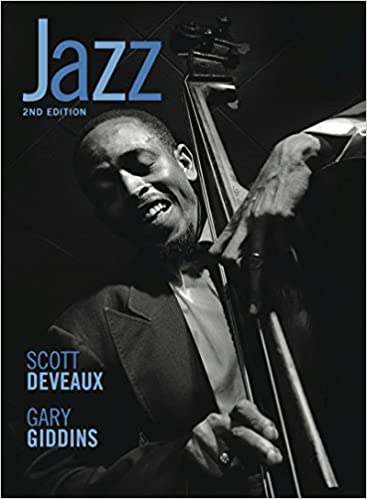
The History of Bebop
By Gary Giddins & Scott DeVeaux (edited excerpt)
In the mid-1940s, jazz stood at a crossroads, along with the country. The war transformed the economy, speeded the pace of life, and spurred the demand for civil rights. Segregated black troops who fought to liberate foreign lands from tyranny were determined to liberate themselves from a second-class citizenship. Many young musicians, black and white, found a bond and a social message in the jazz represented by the incendiary brilliance of a new generation of musicians who had apprenticed in the big bands but developed contrary ideas of their own.
Swing jazz that had risen from its New Orleans origins to become an extroverted popular music, inseparable from mainstream American culture, turned a sharp corner with the sounds known as bebop, or bop. Jazz was suddenly an isolated music, appearing in tiny cramped nightclubs rather than brightly lit dance halls.
Its music—small-combo tunes with peculiar names such as “Salt Peanuts” and “Ornithology”—was complex, dense, and difficult to grasp. It traded in a mass audience for a jazz cult that revered musicians known by terse, elliptical names, real or bestowed: Bird (Charlie Parker), Diz (Dizzy Gillespie), Klook (Kenny Clarke), Monk (Thelonious Monk), Bud (Bud Powell), Dex (Dexter Gordon). Like swing, bebop was still a music that prized virtuosity; if anything, its standards were higher. But most people saw it as an outsider’s music, especially after it developed fault lines associated with drug abuse and racial hostility.
Jazz historians, taking a cue from musicians and fans, initially described bebop as a revolution, emphatically breaking with the past. In 1949, the incalculably influential alto saxophonist Charlie Parker insisted that bebop was a new music, something “entirely separate and apart” from the jazz that had preceded it. This view suggests the existence of powerful cultural force that pushed musicians out of conventional career paths into an unknown risk-filled style.
The Jam Sessions
Historians today, however, tend to treat bebop as an evolution from swing, placing it firmly in the center of the jazz tradition while acknowledging that its status was altered to that of self-conscious art music. The evolutionary view links bop to a particular backstage phenomenon of the Swing Era: the jam session.
Charlie Parker and other young Turks could be heard regularly at Minton’s Playhouse, on 118th Street in Harlem, which hosted some of the most celebrated jam sessions in Manhattan. Many of the innovations that took place there reflected its professional clientele’s hunger for musical challenge.
How bebop changed drumming
As Kenny Clarke once explained it, his technical breakthrough came when he was playing for a swing band led by Teddy Hill in the late 1930s. During an exceptionally fast arrangement of “Oľ Man River,” he found it nearly impossible to keep time in the usual fashion by striking his bass drum for each beat.
Suddenly it occurred to him to shift the pulse to the ride cymbal. This innovation gave him two new tactics: a shimmering cymbal that became the lighter, more flexible foundation for all of modern jazz, and the powerful bass drum, now available to fill in the holes in the band’s arrangements with its thunderous booms.
Clarke’s style was not popular with musicians who had become used to the heavy swing beat. “He breaks up the time too much,” one musician complained. Reluctantly, Hill let Clarke go in 1940. But in an ironic twist, when Hill’s own band collapsed shortly thereafter, his next employer was Minton’s owner, who was looking for someone to stimulate the sessions at his new Playhouse.
Realizing that the drum techniques that had irritated and bewildered musicians in a dance hall might delight them in a jam session, Hill brought Clarke into the Minton’s Playhouse rhythm section, where he soon earned the nickname “Klook” because his combined snare drum and bass drum hits evoked a “klook-mop” sound.
Given the startup of the war and especially the recently endured Battle of Britain, Clarke’s style of unexpected bass drum explosions was referred to as “dropping bombs.” Young, hip musicians fell in love with Clarke’s simmering poly-rhythms. Drummers like Max Roach and Art Blakey found in his playing the methods they needed for a more modern style.
Bebop: Complex dissonant harmonies
To be sure, these sounds had been part of the jazz vocabulary for years. Art Tatum turned popular songs into harmonic minefields through the complexity of his chord substitutions, leaving other musicians—including a nineteen-year-old Charlie Parker, who worked as a dishwasher in a restaurant that featured Tatum—to shake their heads in wonder.
Arrangers listened closely to Duke Ellington’s instrumentation, trying to decipher how he voiced his astringent chords. Improvisers took their cue from Coleman Hawkins, who showed in “Body and Soul” how to use dense chromatic harmonies in popular song. The challenge for the bebop generation came in translating these dissonant harmonies into a vocabulary all musicians could share.
Soloists and members of the rhythm section had to learn to coordinate. This could be done deliberately, as when Dizzy Gillespie and bassist Milt Hinton got together on the roof of the Cotton Club and planned substitute harmonies for that evening’s jam sessions. At other times, harmony was emboldened by the shock of discovery. When Charlie Parker first heard pianist Tadd Dameron’s unusual chord voicings, he was so pleased he kissed him on the cheek. “That’s what I’ve been hearing all my life,” he said, “but nobody plays those changes.”
The Tritone
The new harmonies fastened onto dissonances like the tritone—the chromatic interval known to the Middle Ages as the “devil in music” and to the beboppers as the flatted fifth. (The unimpressed Eddie Condon, a rebel turned traditionalist, commented, “The boppers flat their fifths. We drink ours.”)
The tritone could be found in the chords used by pianists like Dameron and in the spiky solos musicians like Gillespie devised in response to them. Other extended notes (sixths, flat ninths) were added to the palette, making the job of harmonic improvisation that much more difficult. Keeping track of such harmonic nuances was a demanding task, turning a physical, emotional music into the realm of the intellectual. “With bop, you had to know,” trumpet player Howard McGhee stated firmly. “Not feel; you had to know what you were doing.”
Charlie Parker & Dizzy Gillespie
Gillespie and Parker first crossed paths in the early 1940s. Parker reveled in Gillespie’s radiant sound and his deep knowledge of harmony. Gillespie focused on the fluidity of Parker’s phrases: “Charlie Parker brought the rhythm” he said. “The way he played those notes.” The two worked side by side in 1942, when Earl Hines hired them for his big band.
Two years later, they again joined forces when Hines’s vocalist, Billy Eckstine, started his own band. With Gillespie serving as music director, Eckstine’s was the first big band to fully embrace bop, recruiting young players who would become major jazz stars (among them Sarah Vaughan, Gene Ammons, Art Blakey, Dexter Gordon, Sonny Stitt, Fats Navarro, and Kenny Dorham) and astonishing audiences everywhere it played—including a concert in St. Louis, where a teenage Miles Davis sat in, becoming a member of the band when it traveled to Chicago.
Bebop Classic Tunes
Tunes like “Salt Peanuts” and “A Night in Tunisia,” with their tricky interludes, elaborate breaks, and sudden shifts in texture, now seem naturally adaptable to the big-band environment. Yet the new music remained unnerving to many, including record company executives who would only record Eckstine as a blues singer and romantic ballad crooner, keeping the musicians in the background.
The nascent style of modern jazz never found way to a mass audience, and by the end of 1944 Dizzy and Bird had quit the Eckstine band, turning instead to small groups as the best present their music. With the draft depleting the ranks of big bands and a cabaret tax inclining venues to put tables and chairs where once there were dance floors, the advent of small bands was inevitable.
The new ensembles
But the kind of group Parker and Gillespie had in mind was nothing like the winnowed ensembles that the big bands had offered for contrast. It would have to embody the daring and impetuousness of a jam session, but rehearsed and charged—it would have to pin your ears back.
By the time Gillespie brought a quintet to 52nd Street, the emergent style was known as bebop, though serious types preferred Modern Jazz. In tightening up the flamboyant go-for-broke music heard at Minton’s, it added a new and decisively challenging wrinkle: at the beginning of a tune, where one might expect to hear a familiar harmonized melody, the horns played a bare, sinuous theme in disjointed rhythms, confusing those not already familiar with the Harlem jam sessions and offering no clue of what was to come.
In this way, the jam-session style, already shielded from the public, became a way of transmuting blues and standards into a new repertory. The white swing drummer Dave Tough, who heard the 1944 band, remembered its uncanny impact: “As we walked in, see, these cats snatched up their horns and blew crazy stuff. One would stop all of a sudden and another would start for no reason at all. We never could tell when a solo was supposed to begin or end. Then they all quit at once and walked off the stand. It scared us.
If they had listened closely to tunes with such watch-your-step titles as “Ornithology,” “Anthropology,” “Bebop,” “Groovin’ High,” and “Now’s the Time,” they would have recognized familiar structures and harmonic progressions. But they weren’t supposed to recognize them; these tunes were contrived to announce a brave new world.
They were also designed to play hide and seek with the copyright laws. In the United States, the melody of a tune can be protected, but not its chord progression, encouraging jazz musicians to create “original” tunes by superimposing a new melody over the changes of a copyrighted pop song. Tunes like “I Got Rhythm,” “How High the Moon,” “Honeysuckle Rose,” and “Indiana” were frequently recast as harmonic grids for bop originals, relieving the record companies of the irritating obligation to pay royalties and leveling the playing field for musicians whose improvisations were not covered by copyright.
- Gary Giddins & Scott DeVeaux, Jazz, reprinted with permission (click link to purchase)

